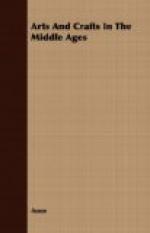During the Renaissance especially, goldsmith’s work was carried to great technical perfection, and yet the natural properties of the metal were frequently lost sight of, and the craftsmen tried to produce effects such as would be more suitable in stone or wood,—little architectonic features were introduced, and gold was frequently made to do the work of other materials. Thus it lost much of its inherent effectiveness. Too much attention was given to ingenuity, and not enough to fitness and beauty.
[Illustration: Reliquary at Orvieto]
In documents of the fourteenth century, the following list of goldsmiths is given: Jean de Mantreux was goldsmith to King Jean. Claux de Friburg was celebrated for a gold statuette of St. John which he made for the Duke of Normandy. A diadem for this Duke was also recorded, made by Jean de Piguigny. Hannequin made three golden crowns for Charles V. Hans Crest was goldsmith to the Duke of Orleans, while others employed by him were Durosne, of Toulouse, Jean de Bethancourt, a Flemish goldsmith. In the fifteenth century the names of Jean de Hasquin, Perrin Manne, and Margerie d’Avignon, were famous.
Artists in the Renaissance were expected to undertake several branches of their craft. Hear Poussin: “It is impossible to work at the same time upon frontispieces of books: a Virgin: at the picture for the congregation of St. Louis, at the designs for the gallery, and for the king’s tapestry! I have only a feeble head, and am not aided by anyone!”
A goldsmith attached to the Court of King Rene of Anjou was Jean Nicolas. Rene also gave many orders to one Liguier Rabotin, of Avignon, who made him several cups of solid gold, on a large tray of the same precious metal. The king often drew his own designs or such bijoux.
Among the famous men of Italy were several who practised the art of the goldsmith. Ugolino of Siena constructed the wonderful reliquary at Orvieto; this, is in shape somewhat similar to the facade of the cathedral.
Verocchio, the instructor of Leonardo da Vinci, accomplished several important pieces of jewelery in his youth: cope-buttons and silver statuettes, chiefly, which were so successful that he determined to take up the career of a sculptor. Ghirlandajo, as is well known, was trained as a goldsmith originally, his father having been the inventor of a pretty fashion then prevailing among young girls of Florence, and being the maker of those golden garlands worn on the heads of maidens. The name Ghirlandajo, indeed, was derived from these garlands (ghirlandes).
Francia began life as a goldsmith, too, and was never in after life ashamed of his profession, for he often signed his works Francesco Francia Aurifex. Francia was a very skilful workman in niello, and in enamels. In fact, to quote the enthusiastic Vasari, “he executed everything that is most beautiful, and which can be performed in that art more perfectly than any other master had ever done.” Baccio Baldini, also, was a goldsmith, although a greater portion of his ability was turned in the direction of engraving. His pupil Maso Finniguerra, who turned also to engraving, began his career as a goldsmith.




